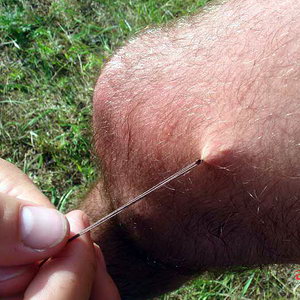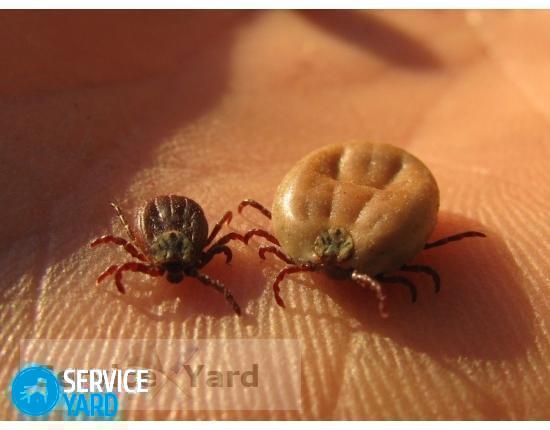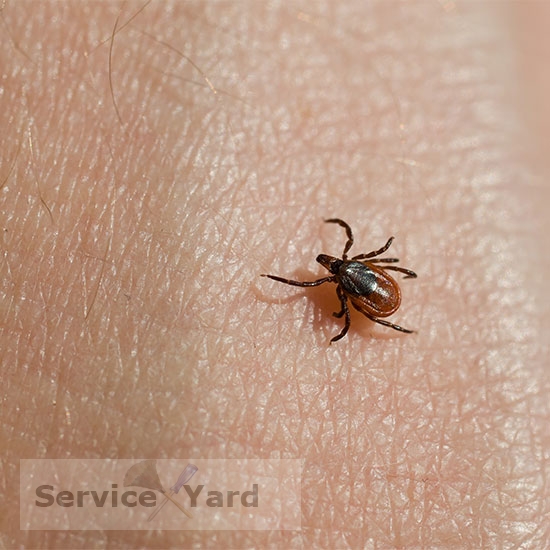How to remove a tick at home?

With the onset of spring, many people strive into the forest with their pets and become easy prey for ticks. The victim can be you or a loved one, as well as animals. If the insect has launched its paws under your skin, you must act carefully and according to the rules, having previously familiarized yourself with how to remove the tick at home.
to contents ↑Description of tick parasites
One of the oldest arthropods on Earth is a tick. Currently, over 48,000 species are described. Arthropods reached such a great flowering due to the fact that in the process of their historical development, they acquired microscopic dimensions. This allowed them to master all layers of soil rich in plant debris.
Only a few species of ticks from the whole variety are parasites that feed on the blood of warm-blooded animals and humans. The most famous of them are ixodid ticks. These insects are dangerous because through bites they carry a lot of dangerous diseases, in particular:
- Borreliosis (Lyme disease).
- Tick-borne encephalitis.
Important! The tick has microscopic dimensions (2-4 mm), oblate, in the horizontal plane, and a very thin red-brownish body. But having pumped blood, the tick can increase in size to 1 cm and acquire a spherical shape. The color changes to light gray. Arthropod can absorb blood arthropod tens of times more than its weight.
Ticks do not have eyes, but this deficiency is compensated by a wonderful sense of smell. The insect can smell the victim at a distance of 10 m. Hanging on the tips of blades of grass or twigs, the mites lie in wait for their prey and cling to the clothes of people passing by or to the hair of animals.
 You can find them already on the shoulders, neck or head, as insects crawl too well in search of a place for a bite. Parasites try to stick in places with thin skin and good blood supply. Usually this:
You can find them already on the shoulders, neck or head, as insects crawl too well in search of a place for a bite. Parasites try to stick in places with thin skin and good blood supply. Usually this:
- The scalp.
- Axillaries
- Neck.
- Auricles.
- Stomach.
Having found a suitable place, the parasite firmly clings its paws to the victim’s skin and pierces it with the proboscis. A person or animals do not feel a bite, as the parasite saliva contains painkillers. In addition, the saliva of the tick prevents the coagulation of the blood of the victim, thereby allowing the arthropod to suck it freely.
The tick, like a gimlet, is screwed under the skin, and if you ignorantly begin to tear out and remove it, part of the insect may become stuck inside. This increases the risk of infection. The removal procedure itself is an unpleasant, but painless thing, if you follow the instructions exactly how to remove the tick at home.
to contents ↑How to remove a tick at home?
There are several methods to get rid of parasites, but the procedure must be done carefully and accurately so as not to tear off the proboscis or the head of the tick. Left in the skin, they will cause inflammation.
Familiarize yourself with some of the ways to get rid of the tick and choose for yourself one whose items you can safely follow.
Method number 1. With tweezers or a surgical clamp
If you already have preliminary skills to remove various bloodsuckers from your body, try to act as quickly as possible to remove the tick at home.For this:
- Grab the tick with your tools as close to the proboscis as possible.
- Gently pull it up, while simultaneously rotating (as if unscrewing) the tick in any direction.
- After 1-3 turns, the arthropod is removed from the wound along with the proboscis.
Important! Do not try to simply pull the parasite out of the skin, as it may burst. Do not grab the tick by the base, so as not to tear or crush it, otherwise - you will inject toxins into the bloodstream.
Method number 2. Using coarse thread or thin lace
Another option on how to proceed to remove the tick at home includes the following points:
- Throw a loop of coarse thread or thin lace on the insect.
- Grab the tick as close to the proboscis as possible. To do this, first stretch the skin with your fingers.
- Tightening the loop, gently swaying from side to side or spinning counterclockwise, slowly pull out the parasite.
Method number 3. Using special tools
Special tick removal tools are currently available. For example, Kinver, Tick Nipper and others. The devices are sold in the pharmacy and are a double-toothed curved fork. To remove the parasite, this hook hooks it so that it is between the teeth, and then gently unscrew the bloodsucker from the skin.
Advantages of special tools:
- They do not compress the body of the tick and, thus, do not allow infections to enter the bloodstream.
- Allow to extract the parasite completely, together with the proboscis.
- Equipped with a special test tube for delivery of the insect for analysis.
What can not be done when removing the parasite?
 No matter how difficult the problem seems to you, how to remove a tick at home, how quickly you notice it and other factors, never do the following:
No matter how difficult the problem seems to you, how to remove a tick at home, how quickly you notice it and other factors, never do the following:
- Do not douse the tick with caustic liquids: ammonia, gasoline, vinegar, etc.
- Do not burn the parasite with the tip of a cigarette.
- You can’t pull the tick with a jerk, try to crush it and poke around the wound with a dirty, unprocessed needle.
- Do not apply compresses to the bite, as this will worsen the situation and will not save from a possible infection.
Useful Tips:
- If you find a sucking parasite in the forest, but there are no suitable tools, then use an ordinary needle or pin. It is advisable to treat the tool with alcohol.
- After removing the insect, be sure to treat the wound with an antiseptic: iodine, brilliant green, alcohol, etc.
- Rinse all tools and hands thoroughly after use.
- If the tick after extraction turned out to be alive, then place it in a jar and take it to a medical institution for examination for virus infection. If you removed the parasite in the forest, it is better to burn it.
- If a part of the tick is deeply ingrained under the skin and the proboscis sticks out above the surface of the skin, then remove it by holding with forceps or consult a surgeon in the clinic. If part of the proboscis remains, soon a small abscess may form in this area, and after some time the remains of the parasite will come out with the pus.
- Before you go to the forest, prepare the necessary tools: take a first-aid kit with you and treat your clothes with special tools that repel ticks.
- Many doctors do not recommend using the method of strangulation of the parasite, that is, processing it with vegetable oil. Blockage of the airway of the tick can lead to its death immediately under the skin, and the parasite will have time to inject poison into the wound.
Prevention methods
So that you have to deal with such a problem as rarely as possible, follow preventative measures. They are not complicated, but allow you to protect yourself:
- Before you go to the cottage, to the robot out of town or in the forest, vaccinate yourself from tick-borne encephalitis yourself and your pets. The first vaccine is given one and a half months before departure, and after a month you need to make a second injection and only after 14 days from the second vaccination you can safely go out of town.
Important! In urgent cases, if a person does not have time to undergo a course of vaccination, then he is given a human immunoglobulin, which will begin to act in 24-48 hours and will work for about 4 weeks.
- If you have not been vaccinated, going to rest in places where parasites can be, dress in such a way that there are no open areas of the body:
- Clothing should be light tones with long sleeves and a collar.
- Sweatshirts, tuck in shirts.
- Trousers are tucked into boots, boots or socks.
- Fasten or tighten the cuffs on the sleeves.
- Tie your neck with a scarf.
- Put a hat or scarf on your head.
- Upon returning home after camping, carefully examine the clothes, as well as the bodies of your loved ones and pets.
- When resting in nature, use tick repellents. Treat them with exposed areas of the body and clothing.
Stock footage
Many experts believe that it is not worth extracting a tick yourself, especially if it is possible to quickly get to a medical facility. Of course, it is better if experts take up the removal of the parasite, since the body of the tick is quite fragile and its head can come off. This very often leads to infection. In addition, the study of a headless insect under laboratory conditions is difficult, and not every laboratory in this case can determine the presence of infection.
But no one knows in what conditions the arthropod “attacked” you, so we hope that thanks to our advice, you will choose the most suitable and acceptable way to remove the tick. And in order not to tempt fate, adhere to preventive measures, heading to the recreation area. Protect yourself, your loved ones, as well as pets from parasites!
- How to choose a vacuum cleaner taking into account the characteristics of the house and coatings?
- What to look for when choosing a water delivery
- How to quickly create comfort at home - tips for housewives
- How to choose the perfect TV - useful tips
- What to look for when choosing blinds
- What should be running shoes?
- What useful things can you buy in a hardware store
- Iphone 11 pro max review
- Than iPhone is better than Android smartphones



